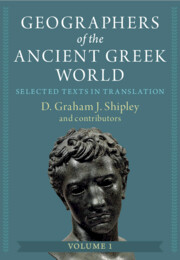Book contents
- Frontmatter
- Dedication
- Epigraph
- Contents
- List of Figures
- List of Maps
- List of Tables
- Contributors
- Preface
- Glossary
- Abbreviations
- Introduction: Greek Geography and Geographers
- Time-line
- Prologue: The Homeric Catalogue of Ships (Iliad, 2. 484–760)
- Part I Archaic Period
- 1 Aristeas of Prokonnesos
- 2 Skylax of Karyanda
- 3 Hekataios of Miletos
- Part II Classical Period
- Part III Hellenistic Period
1 - Aristeas of Prokonnesos
from Part I - Archaic Period
Published online by Cambridge University Press: 25 March 2024
- Frontmatter
- Dedication
- Epigraph
- Contents
- List of Figures
- List of Maps
- List of Tables
- Contributors
- Preface
- Glossary
- Abbreviations
- Introduction: Greek Geography and Geographers
- Time-line
- Prologue: The Homeric Catalogue of Ships (Iliad, 2. 484–760)
- Part I Archaic Period
- 1 Aristeas of Prokonnesos
- 2 Skylax of Karyanda
- 3 Hekataios of Miletos
- Part II Classical Period
- Part III Hellenistic Period
Summary
This chapter presents new, annotated translations of the principal testimonia and fragments of Aristeas of Prokonnesos (archaic period), arranged as six extracts. His lost Arimaspeia, in three books of epic hexameters, told of his journey beyond the Black Sea in the company of Apollo and, some said, in the form of a bird or a disembodied soul. It took him to the Issedones, who told of peoples beyond them: the dangerous, one-eyed Arimaspoi, at war with gold-guarding griffins; the unreachable Hyperboreans, prominent in the mythical geography of the Greeks. The detailed chapter introduction examines Aristeas’ grounding in the Greek experience of the Black Sea, his wider importance across the colonial Greek world, including the far west, and his relationship to Pythagoreanism and Orphism in those parts. Scepticism about Aristeas developed much later; but he is best viewed as a respectable aristocrat from a respected polis (city-state).
Keywords
- Type
- Chapter
- Information
- Geographers of the Ancient Greek WorldSelected Texts in Translation, pp. 109 - 119Publisher: Cambridge University PressPrint publication year: 2024

